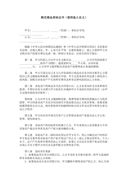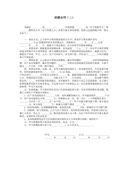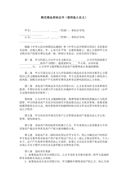Lesson 53-(精选14篇)七年级英语教案
Lesson 53-(精选14篇)
Lesson 53- 篇1
Teaching Objectives: Develop the skill of speaking: an interview
Properties: Maps, Pictures of Xinjiang and Tibet
Language Focus: go back in a hurry.
Teaching Procedures:
I. Revision
Check retelling given as homework last time
II. Leading - in
Have you ever been to Tibet or Xinjiang? Show pictures of the two places and ask the Ss to say sth. from their own knowledge. Tell Ss Erik has been there.
III. Practice
1. Ask the Ss to do the match exercise by themselves.
2. Check the answer
3. Pairwork: practise the interview between Li Weiyin and Erik.
4. Act out the interview.
IV. Practice
1. Interview Erik and Elsa. Ask one group of Ss to be interviewers and prepare interview possible questions. The other Ss are Erik and Elsa. They should be ready for being interviewed.
2. Act out the interview.
V. Exercise in class
Reorder the following sentences.
1. Erik went to Xinjiang by train.
2. He liked Tulufan best.
3. He went back to Sweden.
4. The people of Tulufan are friendly, and their music and dancing are beautiful.
5. Erik went to Tibet.
Key: l 2 4 5 3
VI. Homework
1. Writing; Interview Erik and Elsa
2.Wb
VII. The design of the blackboard
Did you visit any other part of China?
What did you see there?
I wasn’t in a hurry.
Lesson 53- 篇2
Teaching Objectives:
Go on learning the simple past tense and enable Ss to remember the past form of regular and some irregular verbs.
Talk something about robots.
Properties: Tape recorder, multi-media computer
Language Focus: go on a trip robot start doing finish doing
Teaching Procedures:
I. Revision
1. Suppose a student were the businessman in Lesson32, say something about himself.
2. Dictate the words in Unit 8.
II. Leading - in
1. In the nowadays world, science and technology are developing faster and faster.
Can you say some latest and most sophisticated technology?
Have you ever imagined that one day a memory robot can be taken with you and do many things for you? What can they do?
2. (With the help of multi-media) show some pictures of robots if possible.
III. Presentation
1. Today, we’ll meet Mr. Mott, his wife Susan and his memory robot. You’ll see what the memory robot can do for Mr. Mott.
2. Describe picture in the book.
3. Describe the robot.
4. What can a robot do and what do you want a robot to do for you?
IV. Reading
1. Listen and repeat the two dialogues in the book.
2. Ask the Ss the question: “what can the memory robot do for Mr. Mott?”
3. Ask the Ss to give the past form of the verbs in the dialogue.
(1) do (2)pack (3)get (4)go (5)buy (6)read (7)come (8) start ( 9 ) finish (10) teach
Keys: (1) did (2)packed (3)got (4)went (5)bought (6)read (7) came (8)started (9)finished (10)taught
4. Go over the language points
go on a trip: Mr. Mott will go to a trip tomorrow.
robot
start/finish doing
eg. Most Beijing students start learning English at the age of 10.
Jack started doing his homework at 5:00 and finished doing it at 6:00.
Have you finished writing your novel?
5. Listen and read after the tape.
V. Practice
1. Group work: ask the Ss to work in groups of three. Mr. Mott, Susan and the robot and act out the first dialogue
2. Pair work: ask the Ss to work in pairs. Mr. Mott and the robot act out the second dialogue, add something to continue the dialogue.
VI. Exercise in class
Dictation
Mr. Mott is very busy. He often has a lot to do, but his memory is poor. He always can't remember many things. The memory robot really helps him a lot.
Last week, Mr. Mott went to Beijing on business. He asked his robot for help. The robot remembered all the things he did, when he got up, what he did before and after breakfast, whether he packed his things and so on.
Mr. Mott thanks his memory robot a lot.
VII. Homework
1. Wb
2. Writing: A Robot Designed By Me
Write a short article about the robot you design. It’s appearance. What can it do. Why is it useful and anything you like.
You can draw a robot for your teacher.
VIII. The design of the blackboard
Lesson 53- 篇3
教学目标
学会描述四季天气,信的基本写法。
教学用具
投影仪、录音机以及用过的外国的信封、信纸等。
教学步骤
step 1 revision
1. duty report: 让值日生报告,包括以下问题: what day is it today / tomorrow?what day was it yesterday? what is the date today / tomorrow? what was the date yesterday?等,并问学生what’s the weather like today? 老师可自己回答 it’s fine / cold.
2. review the names of 12 months and four seasons.
step 2 presentation
1.通过叙述四季教新单词。如能配合媒体效果会更好。老师可看着媒体描述四季,让学生们注意听。
spring is the first season of the year. the weather is very warm. 教warm, weather. i like spring best. everything begins to turn green. flowers come out. we can wear beautiful clothes, again. 教 come out. summer is the warmest season of the year. it often rains, sometimes quite heavily, in the south. 教 heavily. the crops grow very quickly. 教 crop. autumn is the busy season of the year. we often help them with their harvest. we really enjoy working on the farm. because i like working better than having classes in the classroom. 教really. winter is the coldest of the year. old people don’t like it, but children like it. because it sometime snows, sometimes very heavily. 教snow. children can make a snowman. 教snowman.
引导学生讨论re-reading questions。先找一两个较好的同学说一说,再找几个小组的学生代表在全班展示。
2.观察信的格式
信纸的右上角写什么,称呼用什么标点,落款写什么。
阅读p.12, p.69和p.153三封信。让学生总结写信应有些什么套话。
老师可总结一封信的格式, 用你自己学校的地址。
观察sb p132 信封的写法。也可给让学生看一个真正的用过的信封、信纸。
让学生听录音,并跟读。
step 3 practise
1)让学生快速阅读这封信,say something about the weather in spring, summer, autumn and winter in hangzhou.
2)say something about the four seasons in beijing. 可以小组讨论后,代表发言,也可个人发言。
1. there are four seasons in beijing.
2. it’s windy in spring. it’s warm in autumn.
it’s hot in summer. it’s cold in winter.
3. people like to have a picnic in spring.
they like to swim in summer.
they like to go outing in autumn.
they like to go skiing in winter.
addition: how many kinds of sports do you know?
eg. running, skating, playing basketball, playing football, playing volleyball, the high jump, the long jump, relay race.
3)做workbook
step 4 exercises in class
t: let the students close their english books and fill in the missing words according to the letter. then check the answers.
___1__helen,i___2___you are well. thank you___3__your last letter. you__4___me about the weather here in china. there__5__four seasons in a year___6__spring,__7__, autumn and winter.
i think spring is the___8__season of the year. the weather___9___warmer, and the days___10__longer.___11__the fields everything begins to___12__. trees__13__green, and flowers start to come__14__.
summer__15___after spring. it is the__16__season. it often reins .sometimes quite__17___ the crops grow very quickly. many people love this__18__of year, __19__it is good for___20__. i often go___21__, sometimes in a___22_near my home, and sometimes in a___23__. i enjoy it very___24__.
___25__is a busy season. the days get___26___and the nights get__27__. it is the harvest time, and all farmers are___28__.often, we help them___29_the harvest.__30__month we helped them with the rice harvest. we really enjoyed__31__on the farm.
the coldest season of the year is winter. some people___32___like winter, __33_i like it. sometimes it snows, and the land is___34__white. then we can play in the mow. i like to___35___snowmen.
how many seasons are__36___in your country? i___37__it is cold all the year __38__.there are not four seasons,__39__there?
_____40___
wang wei.
keys: 1. dear 2. hope 3. for 4. asked 5. are
6.here 7.summer 8.best 9.gets 10. get
11. in 12.grow 13.turn 14.out 15.comes
16.waimest 17.heavily 18. time 19.because 20.sports
21.swimming 22.lake 23.river 24.much 25.autumn
26. shorter 27. longer 28. busy 29. with 30. last
31.woiking 32.don’t 33.but 34.all 35.make
36.there 37.hear 38.round 39.are 40.yours
step 5 homework
1. read the letter fluently.
2. make sentences with the useful expressions.
3. try to write a short english letter.
假如helen 给你也写了一封信,让你谈谈你家乡的四季,请你回一封信。
step 6 the design of the blackboard
Lesson 53- 篇4
Period: The Fourth Period
Content:
Properties: Recorder; Overhead Projector.
Teaching Objectives:
1. Practise listening.
2. Do the writing according to the diagram.
Teaching Procedures:
I. Showing the teaching aims
II. Revision
Choose some useful sentences from the students' homework and read them to class, then do more oral practice using the Future -in-the- Past Tense.
III. Leading in
Say: today we're going to hear about different languages in the world, and have the students look at the Exercise 1 in the workbook, read all the questions first, then read the numbers aloud. Try to guess the answers before listening.
IV. Listening
Listen to the tape and do Exercises. The answers are: 1.A 2.B 3.A 4.C 5.B 6.B 7.C 8.A
Check the answers with the whole class.
V. Practice
Ask the students to look at the diagram in Part 2. Discuss it with the students, let them understand the information. Ask the students to do the exercise in pairs. Then check the answers orally. Finally get them to write down the whole passage. Pay attention to the first sentence, it means the people will not be able to find room to stand in if the population is too large. The answers are: small, slowly, quickly, faster, more, smaller, fewer, healthier
VI. Look and ask
Ask the students to look at the list of cards and let the students ask and answer in Pairs. For example: A: How much is the car? Or what’s the price of the car? Or how much does the car cost? B: It’s… Then discuss about why your car is the best.
VII. Presentation
Ask the students: Do you like travelling in your holiday, let the students discuss. Then tell the students we'll learn something about Sam, ask the questions:
1. Which countries would he travel to for holiday?
2. Was his plan very good?
Listen to the tape and answer the questions. Play the tape for the students to listen and repeat. Explain some language Points:
1. travel to…
Last year Sam travelled to Beijing.
2. become interested in:
He became interested in science when he was eight years old.
3. be busy doing something:
The students are busy reading English now.
VIII. Checkpoint 13
Go through Checkpoint 13 and make sure the students can understand the grammar and useful expressions.
IX. Workbook
Do Exercises 2 and 3, ask the students to do them in pairs.
Do Exercise 4. The answers are: 1. would go, would get 2 would be, would be, said, would be, received 3 decided, didn't know, would teach, said, would leave, wouldn't be 4 was, found, would use, down loaded, made
Exercises in class
Rewrite the sentences.
1. What’s the population of the world?
_________ _________ people _________ _________ in the world?
2. My home is twenty minutes on foot.
It __________________ 20 minutes to go home.
3. I forgot everything, so did Jim.
________I ________ Jim could ________ everything.
4. He was late for school, I was late, too.
He was late for school, I ________ ________ ________, ________.
X. Homework
1. Revise the whole unit.
2. Use the useful expressions to make up a story.
3. Finish off the exercises in the workbook.
Lesson 53- 篇5
一、教学目的
1.掌握四会单词、词组,了解词义,搭配及用法。
be small with tree house
have a look in the tree
2.巩固There be句式。
3.了解选择疑问句及回答。
二、本课重点
1.掌握四会词,词组。
2.灵活、正确使用There be句式。
三、本课难点
选择疑问句。
四、教师教法
本课与上两课在内容上没有联系。但是,对于句式学生已经比较熟练了。看到本课的挂图,通过教师的介绍,本课生动有趣,符合学生们的心理年龄特点,学生们的兴趣会很高,会主动去思维,回答、猜想问题的答案,在问答过程中自然而然的解决本课知识点。
五、教具
挂图,投影片。
六、教学过程
Step 1 Revision
1.Free talk
学生自由表演本单元对话。
2.利用班级实物以列为单位进行连锁式快速问答比赛。
3.教师同时挂出第43课挂图。Look at the picture, today we’ll learn lesson 43(板书)。
Step 2 Presentation
T:Look at the picture. It is a tree house. Do you like to play in the tree house?
S:Yes, we do.(把学生的兴趣调动起来)
T:There is a big tree behind Li Lei’s house. In the big tree, there is a small play house. Do you know big and small?(辅以手势,让学生明白)It is a tree house(稍作解释tree house)Li Lei and his friends like to play in the tree house(解释like to play,例:Do you like to swim?…)问学生Do you like to play in the tree house?Why?What’s in the tree house?Can you Guess?教师提出问题后,由学生自由想象,发挥回答,练习There be句式。
Step 3 Drill
1.让学生两人一组,一问一答练习。
2.抽出几组问答。
Step 4 Presentation
Look at the picture. Can you find Tom and Bill? Where are Tom and Bill?
Yes, they are up there in the tree. Pay attention to the prepositional phrases in the tree and on the tree.
例:The apples are on the tree.苹果在树上。
I’m in the tree.我在树上。
强调外来的东西在树上用 in the thee,属于树本身的东西在树上用on the tree.
Tom is in the tree will Bill. Pay attention to “with”. It is a preposition. It means“和、跟” in Chinese,表示伴随。
例:Go with me. 跟我走。
The teacher came in with a book. 老师拿着一本书进来了。
1. Open the books, 学生自读,教师答疑。
(1) Great! 太好了,表示语气惊叹。
(2) have a look 看一看。
例: Is this your book? Let me have a look. 这是你的书吗?让我看一看。
have a look 与 look 同义。
例: Look at your book.
Have a look at your book.
(3) 选择疑问句,由一般疑问句 + or…?构成。语调是or前面为升调,or后面为降调。回答时不能用Yes或No, 应从两个选项中择其一。
例: Are you a boy or a girl?
I'm a boy. 我是男孩。强调不能说 Yes, I’m a boy.
Is it a desk or a chair? It is a desk.
Step 5 Practice
Step 6 Consolidation
I. 选择正确答案
1. Are you Li Ming or Li Lei?
A. Yes, I am Li Ming. B. No, I am not Li Lei.
C. I'm Li Ming. D. Yes, I am.
2. Can you see the apples __________ the tree?
A. in B. on C. with D. at
3. That coat is nice. Please let me ___________.
A. see B. look C. have a look D. look at
4. Li Lei ___________ Li Ming go there _________ the teacher.
A. and, and B. with, and C. and, with D. with, with
5. There __________ a table, two beds and a clock in the room.
A. am B. is C. are D. be
6. There ________ two beds, a table and a clock in the room.
A. am B. is C. are D. be
II.句型转换
1. He's up there in the tree. (就画线部分提问)
2. There's a tree house in the tree. (就画线部分提问)
3. Lily and Lucy are under the tree. (就画线部分提问)
4. The table is big. (与Small构成选择疑问句)
Step 7 Workbook
1. Do Ex. 2: Key words: Who, What, Where, Which, How.
2. Do Ex. 3: Key words: There, are, some, boys, and, girls, in, it.
Step 8 Summary
1.选择疑问句的构成,语调及回答。
2.big- small 互为反义词,big means not small.
3.知识点:have a look in the tree with there
Step 9 Homework
1.记忆本课单词,词组。
2.改编、扩充本课对话。
3.预习下课单词及课文。
4.书面完成Workbook.
七、板书
Lesson 53- 篇6
教学目的(Teaching Objectives)
(1)掌握重点单词和词组hurry up. go the wrong way, be tired。
(2)熟练掌握be going to 结构的用法
(3)能回答课文的问题并能根据上下文判断单词的意思。
教具(Properties) 教学磁带,图片和卡片。Properties: tape recorder, calendar. .
教学过程 (Teaching Procedures)
Step 1 Organizing the class
Greeting end a duty report
Step 2 Review
1. To say sentences according to the calendar about Charlie’s holiday plan.
eg. Charlie is going to catch the nine o’clock train to his uncle’s home. etc.
Step 3 Leading - in
T: Last lesson, we have known the students are going to have a field trip to mountain. Today we’re going to see what they met on their trip.
Do you think they have a good time? Are there any problems? (Encourage students to guess about their trip.)
Students Listen to the tape with their books closed and try to write down the problems. Call one student to write on the blackboard.
Step 4 Presentation
学生默读课文,了解课文大意。并对下列句子进行判断。
A: they go to the top of the mountain to have a picnic.
B: they have no problem getting there.
教师就生词和难点进行举例解释。
To draw a mountain on the blackboard, teach the phrase “on the top of” pointing to the top and “at the foot of the mountain” pointing to the loot of it “To have a picnic means to carry your food. and eat in out doors” “To trip over sth means to fall down because of sth”
e.g. I want to climb to the top of the mountain first.
Tomorrow we are going to have a picnic in a park.” “The boy trips over a lying tree.
Step 5 Practice
Students listen and read the article.
Then they ask and answer about the problems in pairs “What s the matter with Jill?”
“She often goes the wrong way.” etc.
并就教科书78页的练习2进行讨论。然后两人一组问答练习。
Step 6 Practice
教师将课文第七页的1,2,3,4,5副图放大后挂在黑板上。告诉同学这就是当时爬山的情景。
Students guess what the people in each picture are going to say. Then check the answers.
Then students try to find ways to help them. They work in small groups.
最后教师让学生合上课文,根据图片复述课文。
If time permits, they act it out as a role play.
Step 7 Exercises in class
Ed trips over his shoes, so he has to 1 . Jiang Wei is very tired, he wants to 2 . Li Mu has too many things in his bag and it’s too heavy, he needs 3 . Katy wants to hike quickly, she always says 4 . But Jill often goes 5 .
Answers:1. Wear his shoes 2. have a rest 3. help 4. hurry up! 5. the wrong way
Step 8 Homework
1.Do the exercise 2 in page 78 of the textbook
2.To make a role play according to the pictures.
Step 9 The design of the blackboard
Lesson six
be going to
be doing
the word and phrase.
the pictures of the text.
Lesson 53- 篇7
Lesson 12教案示例
重点:复习巩固本单元重点内容
难点:语音
过程:
一、 热身/复习
1. 组织学生唱英文歌曲Happy Teacher’s Day和 韵文Who’s he? Who’s she?
教学开始时,为了帮助学生很快的进入学习状态,唱首英文歌曲,起到活跃课堂气氛以及复习知识的作用。
2.师生之间、学生之间进行问答练习(结合本单元所学的重点句子。)
二、 会话练习与教学方法
1. 听本课的会话整体录音一遍(配套教材录音)
2. 然后让学生模仿录音进行跟读
3. 最后让同桌的两个学生结合成小组进行练习
4. 教师针对课文进行提问,请个别学生回答。从回答中教师可以了解到学生是否理解了课文内容
How many people?
Who’s the boy over there?
Is he American?
Who’s the girl?
5.学生之间问答
找学生到教室前面对其他学生提问题,问题范围:Who’s he/she?
Who’s the boy/girl/woman/man?
Who’s that/this?
Is he/she at home?
学生之间进行问答,可以提问本组成员,也可以提问自己的好朋友,更鼓励学生按学号找学生回答。(提问时可以用自己带来的照片,也可以借用别人的照片)
5. 对话表演
请学生从学过的五篇对话中找出自认为掌握的最好的一篇,找自己座位周围的同学结合成小组,准备对话表演。
对话表演 (三至四组)
三、 语音及拼读练习
1.教师板书字母Oo,并标上读音[EU],然后对全班说:Read it please.
依照此法复习其他音标
2.游戏:音标和单词配对
准备:自制36张游戏纸牌(也可用旧纸牌进行修改),其中的一半,每张写一个英语单词;纸牌的另一半,每张写一个与这些单词相适应的国际音标。例如:一张blue,一张[blu:]。
操作:开始时,把纸牌洗匀,全部背向上一张一张扣在桌面上。每人轮流翻看两张纸牌,凡是翻到单词和国际音标配对的,就把两张取出,放在自己身边,并且还有翻看纸牌的权利。直到纸牌全部翻完,都被取走为止。谁取到的卡片多,谁就是优胜者。
说明:如果背学生翻开的两张不配对,仍须合在原处。所以,玩这个游戏必须集中注意力,尽量记住已经翻过的纸牌内容,以便轮到自己再翻时可以及时找对。
三到四人一小组,人数太多就没有操作的意义了。
单词的范围为本课2 (Read and listen)中的词汇
教师应多准备几套这样的纸牌,或提前发动学生准备好纸牌
教师应与其中一组做此项练习,做完后将单词贴在黑板上
3.听录音两遍(配套录音)
小组内部再次练习读这些单词(还是刚才做游戏的小组)
板书两个原因字母在单词中的发音,带读两遍
四、兴趣活动
1. 做“猜人”游戏:目的是为了复习Who’s this/that? That’s/It’s…
Who’s he/she? She’s/He’s…
2.师生之间,学生之间打电话:目的是为了复习Is he/she at home? No, he/she isn’t at home.
五、练一练(做课堂练习第十二课内容)
根据录音的顺序,在每组单词后面的括号内标出相应的序号
根据录音内容,在每个句子中的空白处填上所缺的单词
六、作业 :朗读并抄写课堂练习中归纳的本单元的句子
七、板书设计 :
教案点评:
本课综合了本单元前五课的重点句型、重点词汇I、you、he、she、it以及重点语音知识。在歌曲声中开始本课学习,有利于活跃课堂气氛。在呈现新课时,可先放录音,让学生猜猜都有些什么人物。教师可直接提问Who is he? Who's this?等。再结合小组活动,如表演对话、配音、综合语言接龙等,来复习本单元的语言点。最后,进行总结,包括知识总结、学生的能力总结,还可谈谈有效的学英语的方法等。
训练听说的探究活动
1.形式:小组对话
用具:玩具电话数台
操作:发给每组学生一台玩具电话(也可自备),并给学生提供几个不同场景的图片(例如:课文中出现的是:He’s at the zoo. 新提供的就可以是park、school、cinema),以小组为单位,模仿课文对话组织新的语言材料。
2.形式:打电话
用具:玩具电话数台、每个小组一张表格
操作:同样还是以小组位单位可根据教师提供的场景进行对话,准备完毕后,每组轮流到教室前面表演,其他学生在听对话的同时要完成一个有关对话内容表格的填写,具体有关哪个对话,由学生从表演过的对话中自由选择。待所有对话都表演完毕,请几个学生公布他们所填表格内容,从而检查他们是否听清或听懂了对话。
表格内容:
Group number
Who?
At home?
Where?
Lesson 53- 篇8
Step 1 Revision
1 Check the homework .
2 Let the Ss look at the picture in SB page 17, Part 2 for half a minute. Then books closed!
Ask questions about the picture: Who is holding the ladder? etc.
Ss have to answer from memory.
Step 2 Presentation
Call three Ss to the front of the class.
Give the first student a small pile of books, the second a bigger pile and the third a very big pile.
Ask each of them: How many books do you have? Answer this question. Then say: A has some books. B has more books than A. C has the most of all. Repeat. Get the Ss to listen and repeat. Repeat with groups of three Ss and other objects (pens, apples, rulers, etc).
Practise thoroughly. Point to a group of three at the front . The class says: D has some pens. E has more pens than D . F has the most of all. Write these sentences on th Bb .
Teach few/fewer/fewest in the same way.
Step 3 Read and practise
SB page 18, Part 1. Speech Cassette .
Books closed! Play the tape.
Ss listen and repeat. Books open. Talk about each picture. Say to individual Ss: Tell me about Jim. Tell me about the first truck. etc.
Step 4 Ask and answer
SB page 18, Part 2. Speech Cassette .
Ss look at the pictures as they listen and repeat.
Practise the dialogues with the Ss. Let the Ss guess the meaning of strong. Explain He's stronger than her or He's stronger than she are both acceptable. Ask and answer questions according to the text.
Play the part of A and ask: Is Kate picking more apples than Jim? Is the small truck carrying more ladders than the big one? Get the Ss to answer them. Then the Ss practise the dialogues in pairs.
Step 5 Presentation
Call out three Ss and give each one some books, pens and rulers (a different number to each) .
Ask Who has the most books? Who has more pens, A or B? Who has the fewest rulers? etc.
Make sure the Ss understand the questions and get them to ask and answer in the same way.
SB page 18, Part 3. Demonstrate some questions and answers with individual Ss in pairs . Ss ask and answer about the pictures, then make up their own dialogues in pairs .
Step 6 Practise
Groups of three. Each group has to make up four sets of sentences about themselves using some/more/most, few/fewer/fewest or adjectives such as tall, young, short, heavy, etc.
Get some groups to present their sentences.
Step 7 Workbook
Wb , E. 1-2.
Ex. 1 may be done orally. Do the first one with the whole class, then Ss can work in pairs .
Ex.2 may be done orally first in pairs. Check the answers with the whole class.
Homework
Finish off the Workbook exercises .
Learn the sentences in SB page 18, Part 1.
Write down the questions and answers in Wb Ex. 1 in the exercise books.
Lesson 53- 篇9
(一课时或两课时)
教学目标
掌握语音;谈谈自己对四季的看法,说说自己最喜欢那个季节,并说明理由。
教学用具
录影机、媒体设备。
教学步骤
Step 1 Revision
四季和12个月份。
Step 2 Presentation
老师朗读这些句子,朗读两遍,重读动词及反意部分。
It’s fine today, isn’t it? Yes, it is.
You’re from Japan, aren’t you? Yes, I am.
They are waiting, aren’t they? No, they aren’t.
He’s a middle school student, isn’t he? Yes, he is.
She is at home now, isn’t she? No, she isn’t. She is at school.
It was Sunday yesterday, wasn’t it? Yes, it was.
Jim knows the way Australians speak, doesn’t he? Yes, he is.
Han Meimei knows Jim a lot, doesn’t she?
They were watching TV yesterday evening, weren’t they? Yes, they were.
You like spring best, don’t you? No, I don’t. I like summer.
将这些句子用投影仪打出,让学生观察,并总结反意问句的构成,以及它的回答方式。
Step 3 Drill
然后可采用老师说主句部分,由学生练习缩略部分的方式练习。练熟后由学生说主句部分,老师说从句部分,直至练熟。也可在黑板上出一部分句子,写出主句部分,让学生写反意部分。目前只让学生练习前肯定后否定的反意问句,回答部分不必多花时间。
听录音,并跟读。
Step 4 Practise pair work
联系Part 2 可让学生自由发挥,如两人谈谈北京的四季,和你家乡的季节,但主要练习反意问句及其回答。
教单词:true near nearly like unlike opposite
Step 5 Listen and repeat
Open your books and do Exercise One, Lesson 44
Pay attention to these pronunciations.
Read the words again.
T: Now let’s do Exercise Two. Listen to the tape and choose the correct answers on Page 134.
Then check the answers together.
Step 6 Consolidation
1.看图并谈谈北京的四季。一个学生可重点谈一个季节。练习Lesson 43 Part3.
2.让学生编一个对话,谈谈自己所喜爱的季节。引出一个十分有用的句型:That’s true.
仿照Lesson 44 Part3.
A: Which season do you like best, spring, summer, autumn or winter?
B: That’s an easy question. I think I like spring best.
A: Why?
B: Well, I like travelling. You can do a lot of sightseeing in spring. What about you?
A: Can you guess?
B: You like winter, don’t you?
A: Yes. How did you guess?
B: Because you like skiing.
A: That’s true, but I like summer better than winter.
B: Why?
A: Because I can have a long holiday in Summer then.
3.Listen Lesson 44 Part 4 Read.
把你听到的填写在下列表格中,对比中国,美国和澳大利亚。
Spring
Weather
Summer
Weather
Autumn
Weather
Winter
Weather
China
Mar—
May
Warm
England
Amer-
ica
Mar—
May
Austra-
lia
Keys
Spring
Weather
Summer
Weather
Autumn
Weather
Winter
Weather
China
Mar—
May
warm
short
June—
August
hot
Aug.—
Nov.
quite warm
Dec.—
Feb.
very cold
England
Mar.-- May
longer than in China and USA
Not too hot or too cold
Amer-
ica
Mar—
May
A nearly the same as China.
Austra-
lia
Dec.—Feb.
The seasons are opposite of China.
June—Aug.
Ask the students to look at the two pictures in students Book and describe the pictures in their own words.
Let them talk about the weather in China, in England, in the U. S. A. and in Australia.
4. Go over Checkpoint 11
A: Grammar
1. disjunctive questions 2. the prepositions: in, on and at
B: Useful expressions
1. turn green/yellow/… 2. this year/month/… 3. the next year/month/…
4. be different from 5. What is the date today? 6. What’s the weather like?
Step 7 Exercises in class
Listening practice.
Listen to a story and try to answer the following questions.
Everybody talks about weather. “Isn’t it a nice day?” “Do you think it will rain?” I think it s going to snow. These are common ways of starting a conversation in England.
Many people think that they can tell what the weather is going to be like. But they hardly ever agree with each other. One man may say, “Do you see it is cloudy in the east? It’s going to rain tomorrow.” Another man will say, “Yes, it’s cloudy in the east. We’re going to have fine weather tomorrow.”
People often look for the weather they want. When farmer needs water, he looks for something to tell himself that it's going to rain. When people play in a park on a rainy day, they are sure that the weather is going to be fine soon. They even sit eating their lunch while it rains.
Most people listen to what the weatherman says on the radio. But he doesn’t always tell them what they want to hear. Sometimes he makes a mistake, but he is still right more often than anyone else.
Questions.
1. How do English people start a conversation?
2. Do many of them think they can tell what the weather is going to be like?
3. Why do they hardly agree with each other?
4. What kind of weather do people think it’s going to be if they go out to play in a park in the rain?
5. Who is right more often about the weather?
Keys:
1. They usually talk about the weather.
2. Yes, they do.
3. Because each of them is so sure of himself that only he knows about the weather.
4. They think it s going to be fine.
5. The weatherman is.
Step 8 Homework
1. Make up a new dialogue according to Exercise Three.
2. Write about the weather of four seasons in China.
3. Read the text fluently and try to recite it.
4. Review Checkpoint 11 and the whole unit.
5. Go over disjunctive questions.
Step 9 Blackboard Handwriting
Lesson 53- 篇10
Teaching Objectives: Students should grasp the pronunciation of some letter clusters and understand the article.
Language Focus:
I. Pronunciation:
[ : ] er, ur, ir, or, ear [a:]ar, a(ss),al [ u:]ou, ow
II. Useful expressions :
① make sb sth, - make sth for sb ② try to do sth ③ friendly, unfriendly ④ not…any more ⑤ ask sb, to do sth ⑥ help sb, (to) do sth ⑦ a waste of time
Properties: Tape recorder, Overhead projector, cards
Teaching Procedures:
I. Organizing the class
Greeting and a duty report
II. Review
1. Give some names for them to say which is the family name and which is the given name. And how to use the titles Mr./ Mrs./ Miss/ Ms. Remind them that the titles can only be used with a family name.
2. Show a picture for the students to describe in present continuous tense “be doing sth”.
III. Pronunciation
1. Students follow the tape
2. More words to read (on cards)
IV. Listening
Students listen to the tape and do the exercise
V. Leading - in
Teacher: What are you going to do on Saturday?
Student: I’m going to…
T: Can you make a card?
S: Yes, I can.
T: Will you please show us your card?
S: Sure! (They have done that as homework some days before.)
T: Oh, it’s really a nice card. Now let’s see what Tom is going to do before Teachers’ Day (with the questions)
① What does Tom’s mum want him to do?
② Can he do it? why? or why not ?
③ What is the idea Mum thinking out for Tom?
④ Do you think it’s a good idea?
After answering the questions, students follow the tape and act it out in pairs.
VI. Reading practice
Students read the text by themselves and answer the questions:
① Who’s in the story?
Say something about him, eg, name, nationality, likes, etc.
② What’s the mistake the students often make?
③ What does he want now?
④ Who helps him?
⑤ Does he get what he wants?
⑥ Can you help him?
Then play the tape for them to follow.
Students try to retell the story with the questions as clues.
VII. Language Practice
Let’s learn seven useful expressions of this lesson
① make sb sth ____ make sth for sb.
② try to do sth.
③ friendly opposite unfriendly (adj)
④ not… any more
⑤ ask sb. to do Sth.
⑥ help sb. (to) do Sth.
⑦ a waste of time
Listen to my sentences and try to understand them
eg ①I’ll make you a new paper boat→
I’ll make a new paper boat for you.
②The boy is trying to climb the tree.
③The people are friendly to me.
④You’re not a child any more.
⑤My Dad asks me to buy him some newspapers.
⑥Will you please help me do the cleaning?
⑦It’s a waste of time to listen to him.
Then ask the students to make their own sentences with the phrases given above.
VIII. Exercises in class
1. Write out the phonetic symbols.
① bird ② part ③ grass ④how ⑤ trousers ⑥world ⑦ learning ⑧ clerk ⑨ birthday ⑩ blouse
2. To introduce Phillip in 40 words.
Answers: ① [ :] ② [a:] ③[a:] ④[ u] ⑤[ u] ⑥[ :] ⑦[ :] ⑧[ :] ⑨[ :] ⑩[ u]
3. Omit
IX. Homework
1. , exercise 4, to make up a dialogue in pairs and be ready to act (write out script)
2. If they don’t like their English name, they may change it to a new one and make a name card to be placed on the desk.
3. Finish off the workbook
4. Go through the checkpoint, answer any question.
Lesson 53- 篇11
Teaching Objective: Read a passage about the memory robot invent.
Properties: Tape recorder, pictures
Language Focus: bad memory all the time =always watch sb. do
Teaching Procedures:
I. Revision
Ask the students to recall Mr. Mott’s robot: its appearance, functions, etc.
II. Leading - in
1. In the last period, we learnt something about Mr. Mott’s robot, today we’ll know more about it.
2. Talk about students’ writings. In the last period, Ss were assigned a writing. After correcting, the teacher summarizes the Ss’ writings.
What can robots do and why are they useful?
III. Reading
1. Ask Ss to read the text by themselves and finish Ex. 2
2. Check the answers
3. Chain reading the text again
4. Language points
(1) invent v - invention n.
Light is invented by Edison. Light is Edison's invention.
(2) had memory/poor memory
eg. My brother has a poor/bad memory, but I have a very good memory.
(3) all the time =always
eg. It seems that she's studying all the time.
(4) watch sb. doing
eg. Every morning, I can hear my neighbour sing in the kitchen.
I saw him running on the playground when I came into the school.
All the students watched their chemistry teacher doing the experiment carefully in the lab when the bell rang.
5. Retell the lesson
IV. Exercise in class
The Memory Robot
Susan 1 the memory robot, because her husband, Mr. Mott 2 a very 3 memory. The memory robot followed Mr. Mott 4 . It listened to everything he 5 and saw everything he 6 It watched him 7 to his students, 8 his meals, and 9 at night. In a word, the memory robot know 10 about Mr. Mott, 80 did Mr. Mott’s wife.
1. A. invents B. invented c. inventing
2 .A. have B. had C .having
3. A. good B. bad C. well
4. A. all the time B. at times C. sometimes
5. A. says B. said C. saying
6. A.does B. did C. doing
7. A.talk B. talked C. talking
8. A. eat B. ate C. eating
9. A. sleep B. slept C. sleeping
10. A. nothing B. anything C. everything
Key: 1B 2B 3B 4A 5B 6B 7A 8A 9A 10C
V. Homework
1. Wb
2.Retell the lesson
VI. The design of the blackboard
Lesson 53- 篇12
Teaching Objectives:
Go on learning the simple past tense and enable Ss to remember the past form of regular and some irregular verbs.
Talk something about robots.
Properties: Tape recorder, multi-media computer
Language Focus: go on a trip robot start doing finish doing
Teaching Procedures:
I. Revision
1. Suppose a student were the businessman in Lesson32, say something about himself.
2. Dictate the words in Unit 8.
II. Leading - in
1. In the nowadays world, science and technology are developing faster and faster.
Can you say some latest and most sophisticated technology?
Have you ever imagined that one day a memory robot can be taken with you and do many things for you? What can they do?
2. (With the help of multi-media) show some pictures of robots if possible.
III. Presentation
1. Today, we’ll meet Mr. Mott, his wife Susan and his memory robot. You’ll see what the memory robot can do for Mr. Mott.
2. Describe picture in the book.
3. Describe the robot.
4. What can a robot do and what do you want a robot to do for you?
IV. Reading
1. Listen and repeat the two dialogues in the book.
2. Ask the Ss the question: “what can the memory robot do for Mr. Mott?”
3. Ask the Ss to give the past form of the verbs in the dialogue.
(1) do (2)pack (3)get (4)go (5)buy (6)read (7)come (8) start ( 9 ) finish (10) teach
Keys: (1) did (2)packed (3)got (4)went (5)bought (6)read (7) came (8)started (9)finished (10)taught
4. Go over the language points
go on a trip: Mr. Mott will go to a trip tomorrow.
robot
start/finish doing
eg. Most Beijing students start learning English at the age of 10.
Jack started doing his homework at 5:00 and finished doing it at 6:00.
Have you finished writing your novel?
5. Listen and read after the tape.
V. Practice
1. Group work: ask the Ss to work in groups of three. Mr. Mott, Susan and the robot and act out the first dialogue
2. Pair work: ask the Ss to work in pairs. Mr. Mott and the robot act out the second dialogue, add something to continue the dialogue.
VI. Exercise in class
Dictation
Mr. Mott is very busy. He often has a lot to do, but his memory is poor. He always can't remember many things. The memory robot really helps him a lot.
Last week, Mr. Mott went to Beijing on business. He asked his robot for help. The robot remembered all the things he did, when he got up, what he did before and after breakfast, whether he packed his things and so on.
Mr. Mott thanks his memory robot a lot.
VII. Homework
1. Wb
2. Writing: A Robot Designed By Me
Write a short article about the robot you design. It’s appearance. What can it do. Why is it useful and anything you like.
You can draw a robot for your teacher.
VIII. The design of the blackboard
Lesson 53- 篇13
(一或两课时)
教学目标
学会打电话常用的基本用语,你要找的人在和不在两种情况的电话用语。不在的情况下,要会填写电话留言条。
别人邀请你去他家,你有事不能去,如何客气、婉转的拒绝。
会正确应用:May I speak to..., please?
Hold on, please.
…speaking.
Can I take a message?等等。
教学用具
录音机,投影仪,实物电话
教学方法
将对话放入真实的生活情景中演练
教学建议
建议Lesson 50和Lesson 52一起课讲。
教学步骤
Step 1 Revision
让同学们复习以前接触的电话常用语。可组一组对话,如:
A: Hello, this is Kate. Who is it?
B: This is Hanmei. Kate, would you like to come to my home and do homework with me? I want you to help me with my English.
A: Ok. I’d love to, when?
B: What about 3 o’clock?
A: All right, see you then.
B: See you.
注:类似的一组对话可以复习到:This is…, Who is it? Would you like to…等以前的知识。
复习反意问句。让学生们先观察以下句子。它们有些什么共同点。
It starts at 4:30, doesn’t it?
It rains every day here, doesn’t it?
He works very hard, doesn’t he?
She gets up early every day, doesn’t she?
练习
Ann studies very hard, ________ she?
Miss Gao loves us, ________ she?
Li Lei is a good student, __________ she?
It’s a fine day, ________ it?
They all like English very much, _______ they?
Step 2 Presentation
Teacher: Do you like giving phone calls to your classmates or friends? If yes, what would you say first?
1) Hello.
2) May I speak to?
3) This is ××speaking!
4) Who is it? And so on.
You ask the students to understand what to say, and what the purpose of the phone call is.
听第一段录音2遍,请同学们复述(最好用英文)电话中的有关内容,了解这段话发生的环境和结果。
听第二段录音2遍,请同学们复述第二段电话的发生环境和结果。并说出与第一段有什么不同的地方。(第二段要找的人没在)。
打开书,教师解释:take a message和give the message
Step 3 Practice
跟读录音一至两遍。
同学们两两做pairs work, 练习第一段和第二段,直到较熟悉为止。
Step 4 presentation
教单词:telephone: phone double: two times
老师事先和一位同学准备好Lesson 52 对话,双方拿电话机在班上展示。让这位同学在投影片填好电话留言卡,其他同学在老师事先印好的电话留言卡上填写,然后老师在投影仪上订正。提醒学生填写电话留言卡要简单扼要,它的读者只有一个人。如果大都知道Zhang Yujing 是谁,用一句祈使句即可。如:本课的电话卡message内容:
She called you. Please call her.
打开书,跟读录音,pair work,直到较熟悉为止。
Step 5 Practice
1.根据已熟练的知识,请同学们两两设计一段真实的对话,用真实的姓名和实物电话进行表演,全部或部分用上本课重点词语。(此环节可找些学习较好、接受能力强的学生先演练)
2.教师随机叫同学们进行对话练习,学生可自主选择本人接听或非本人接听两种情况进行对话。
Step 6 Consolidation
Rewrite the sentences without changing their meanings.
1. I’m afraid I may be a little late.
I’m afraid ______ I ______ ______a little late.
2. She isn’t here right now.
She is ______ ______ ______ ______.
3. Can I take her a message?
Can I take a message ______ ______?
4. I’m very sorry, but I can’t come.
I’m ______ I can’t come.
5. I’ll get her the message.
I’ll ______ the message ______ ______.
Answers: 1. maybe, will be 2. away at the moment 3. for her 4. afraid 5. give, to her
Step 7 Homework
将课上两两做的pairs work整理成系统完整的邀请对话,内容不限,可以是邀请聚会,去你家做客,一起去买东西等。此作业 可以让学生2人或3人一组共同做一份。
Step 8 Blackboard handwriting
May I speak to …please?
Hold on, please.
... speaking.
I’d love to.
Can I take a message?
Could I speak to …please?
I’m afraid he / she isn’t here.
Thank you for doing…
I’ll give her / him the message.
I’m sorry, but I cannot…
Lesson 53- 篇14
Period: The Third Period
Content:
Properties: Recorder; Overhead Projector.
Teaching Objectives: Revise the distance and dialogues.
Language Focus: the modal verbs, numbers.
Teaching Procedures:
Ⅰ。Showing the teaching aims
Ⅱ。Revision
Revise the text and ask some students to read their retellings in class. Then practise the Present -Perfect Tense.
Ⅲ。Leading in
Get the students to look at the Exercise
1 ) How many kilometres by train is it from… to…?
2) How far away is…from…?
3) What about …?
Tell the students to read the model question. Let them understand this exercise, then get the students to ask and answer in pairs. Finally check the answers with the whole class.
Ⅳ。Practice
Part.2, Let the students look at the diagram, It tells us the distance between cities. Let’s look at the model first.
A: How many kilometres by train is it from Nanjing to Wuhan?
B: 1229. (One thousand two hundred and twenty nine)
A: How many kilometres is it from Kunming to Shanghai?
B: 2677. How many....?
Ask the whole class some questions about the distance. Make sure the students can say numbers correctly. Then divide them into small groups to make up questions. At last, report their work in class.
Ⅴ。Acting
Let the students read Part 3 silently. Ask them to practise in pairs. Pay attention to the modal verbs.
Ⅵ。Workbook
For Exercise 1, ask and answer in pairs.
For Exercise 3. Get the students to read over the sentences and fill in the blanks.
The answers are: was ...repaired, began, make, was told, got, decided, received, found, would be repaired
Exercises in class
Change the following sentences into Passive Voice
1. Bruce writes a letter to his parents every week.
2. Lilei mended the broken kite this morning.
3.1 must buy a Christmas present for Mr. Green.
4. Li Ming can't finish the homework on time.
5. We should water the flowers twice a day.
Ⅶ。Homework
Finish off the exercises in the workbook.

















